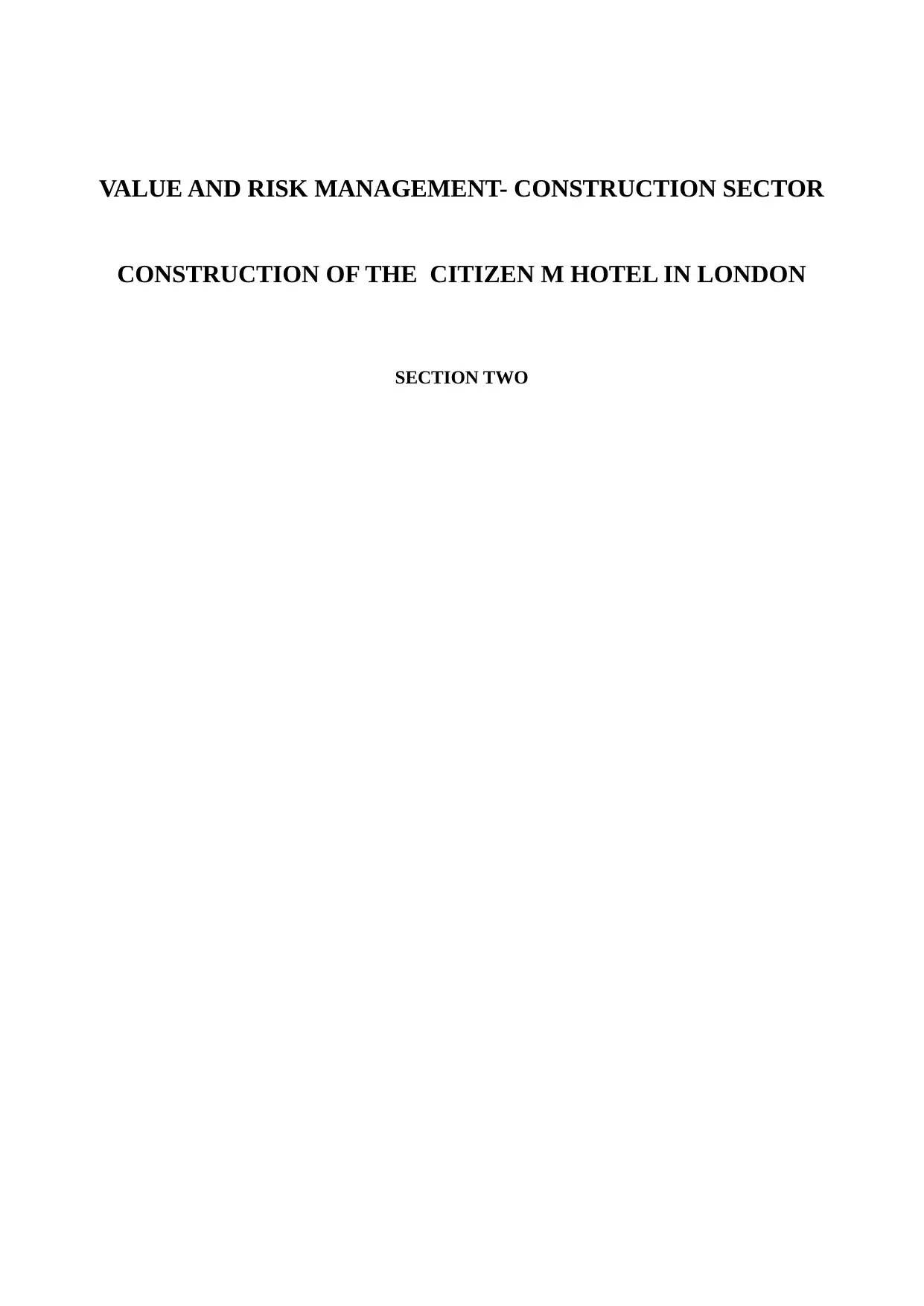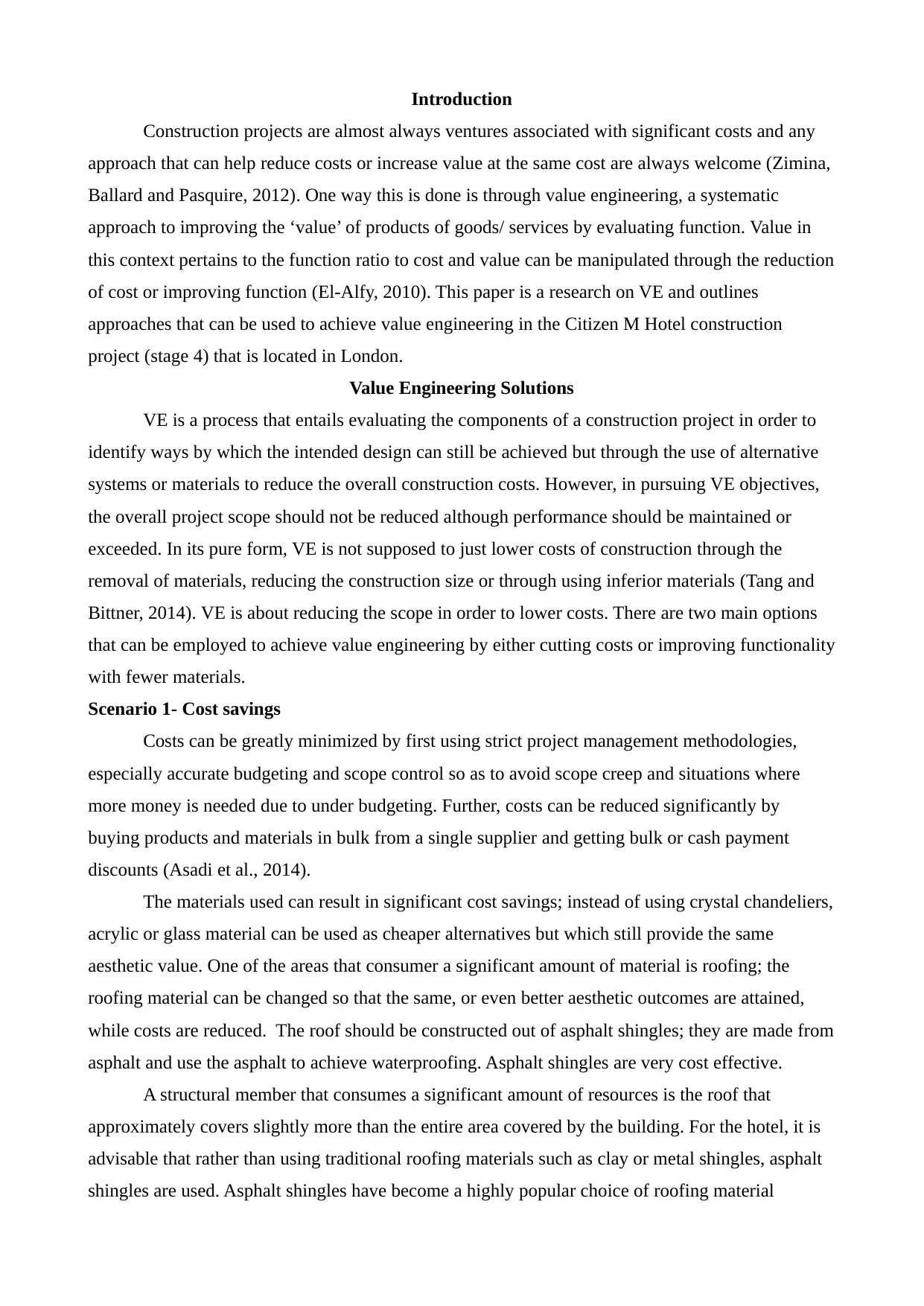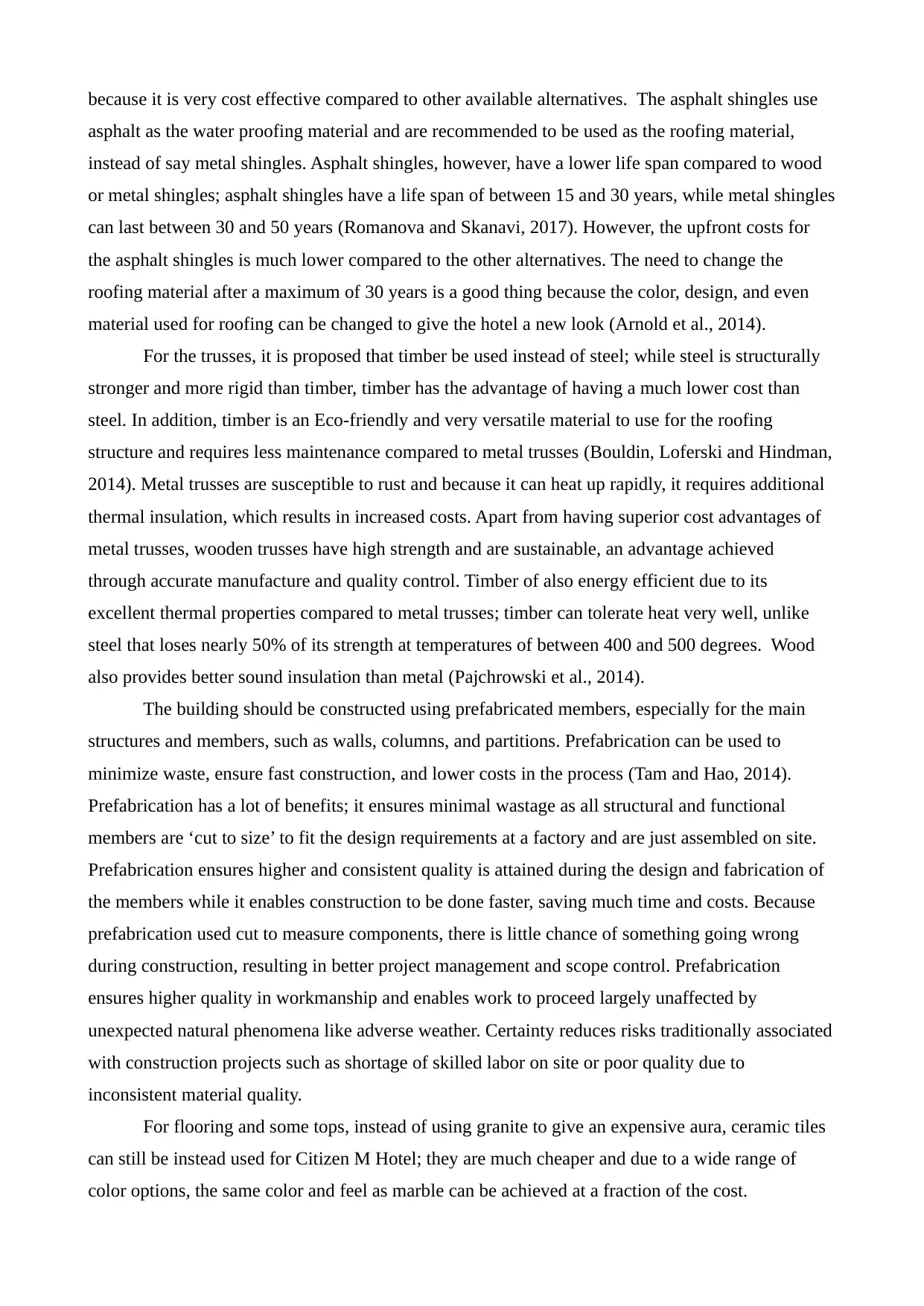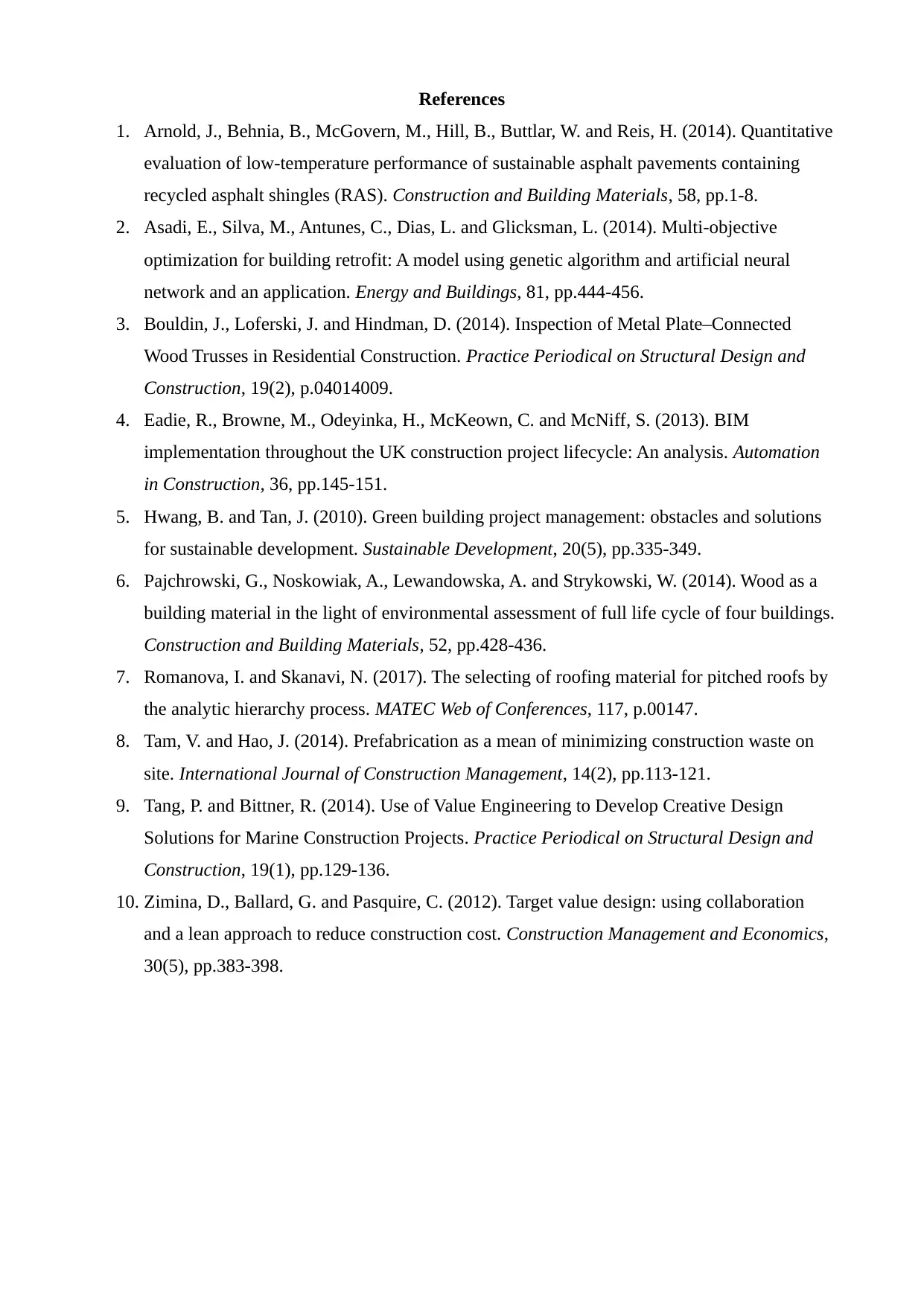D31VR Assignment: Value Engineering for Citizen M Hotel, London
VerifiedAdded on 2022/09/11
|7
|2092
|15
Report
AI Summary
This report provides a comprehensive analysis of value engineering strategies applied to the Citizen M Hotel construction project in London. It explores two main scenarios: cost savings and function emphasis. The cost-saving scenario suggests various methods, including strict project management, bulk material purchases, and alternative materials like asphalt shingles for roofing and timber for trusses to reduce costs without compromising quality. The function-focused scenario emphasizes energy efficiency through solar energy, rainwater harvesting, and the use of durable materials to enhance the building's lifespan and reduce operational costs. The report also highlights the importance of Building Information Modeling (BIM) for life cycle management and value engineering throughout the building's lifespan, referencing relevant literature to support its findings.

VALUE AND RISK MANAGEMENT- CONSTRUCTION SECTOR
CONSTRUCTION OF THE CITIZEN M HOTEL IN LONDON
SECTION TWO
CONSTRUCTION OF THE CITIZEN M HOTEL IN LONDON
SECTION TWO
Paraphrase This Document
Need a fresh take? Get an instant paraphrase of this document with our AI Paraphraser

Introduction
Construction projects are almost always ventures associated with significant costs and any
approach that can help reduce costs or increase value at the same cost are always welcome (Zimina,
Ballard and Pasquire, 2012). One way this is done is through value engineering, a systematic
approach to improving the ‘value’ of products of goods/ services by evaluating function. Value in
this context pertains to the function ratio to cost and value can be manipulated through the reduction
of cost or improving function (El-Alfy, 2010). This paper is a research on VE and outlines
approaches that can be used to achieve value engineering in the Citizen M Hotel construction
project (stage 4) that is located in London.
Value Engineering Solutions
VE is a process that entails evaluating the components of a construction project in order to
identify ways by which the intended design can still be achieved but through the use of alternative
systems or materials to reduce the overall construction costs. However, in pursuing VE objectives,
the overall project scope should not be reduced although performance should be maintained or
exceeded. In its pure form, VE is not supposed to just lower costs of construction through the
removal of materials, reducing the construction size or through using inferior materials (Tang and
Bittner, 2014). VE is about reducing the scope in order to lower costs. There are two main options
that can be employed to achieve value engineering by either cutting costs or improving functionality
with fewer materials.
Scenario 1- Cost savings
Costs can be greatly minimized by first using strict project management methodologies,
especially accurate budgeting and scope control so as to avoid scope creep and situations where
more money is needed due to under budgeting. Further, costs can be reduced significantly by
buying products and materials in bulk from a single supplier and getting bulk or cash payment
discounts (Asadi et al., 2014).
The materials used can result in significant cost savings; instead of using crystal chandeliers,
acrylic or glass material can be used as cheaper alternatives but which still provide the same
aesthetic value. One of the areas that consumer a significant amount of material is roofing; the
roofing material can be changed so that the same, or even better aesthetic outcomes are attained,
while costs are reduced. The roof should be constructed out of asphalt shingles; they are made from
asphalt and use the asphalt to achieve waterproofing. Asphalt shingles are very cost effective.
A structural member that consumes a significant amount of resources is the roof that
approximately covers slightly more than the entire area covered by the building. For the hotel, it is
advisable that rather than using traditional roofing materials such as clay or metal shingles, asphalt
shingles are used. Asphalt shingles have become a highly popular choice of roofing material
Construction projects are almost always ventures associated with significant costs and any
approach that can help reduce costs or increase value at the same cost are always welcome (Zimina,
Ballard and Pasquire, 2012). One way this is done is through value engineering, a systematic
approach to improving the ‘value’ of products of goods/ services by evaluating function. Value in
this context pertains to the function ratio to cost and value can be manipulated through the reduction
of cost or improving function (El-Alfy, 2010). This paper is a research on VE and outlines
approaches that can be used to achieve value engineering in the Citizen M Hotel construction
project (stage 4) that is located in London.
Value Engineering Solutions
VE is a process that entails evaluating the components of a construction project in order to
identify ways by which the intended design can still be achieved but through the use of alternative
systems or materials to reduce the overall construction costs. However, in pursuing VE objectives,
the overall project scope should not be reduced although performance should be maintained or
exceeded. In its pure form, VE is not supposed to just lower costs of construction through the
removal of materials, reducing the construction size or through using inferior materials (Tang and
Bittner, 2014). VE is about reducing the scope in order to lower costs. There are two main options
that can be employed to achieve value engineering by either cutting costs or improving functionality
with fewer materials.
Scenario 1- Cost savings
Costs can be greatly minimized by first using strict project management methodologies,
especially accurate budgeting and scope control so as to avoid scope creep and situations where
more money is needed due to under budgeting. Further, costs can be reduced significantly by
buying products and materials in bulk from a single supplier and getting bulk or cash payment
discounts (Asadi et al., 2014).
The materials used can result in significant cost savings; instead of using crystal chandeliers,
acrylic or glass material can be used as cheaper alternatives but which still provide the same
aesthetic value. One of the areas that consumer a significant amount of material is roofing; the
roofing material can be changed so that the same, or even better aesthetic outcomes are attained,
while costs are reduced. The roof should be constructed out of asphalt shingles; they are made from
asphalt and use the asphalt to achieve waterproofing. Asphalt shingles are very cost effective.
A structural member that consumes a significant amount of resources is the roof that
approximately covers slightly more than the entire area covered by the building. For the hotel, it is
advisable that rather than using traditional roofing materials such as clay or metal shingles, asphalt
shingles are used. Asphalt shingles have become a highly popular choice of roofing material

because it is very cost effective compared to other available alternatives. The asphalt shingles use
asphalt as the water proofing material and are recommended to be used as the roofing material,
instead of say metal shingles. Asphalt shingles, however, have a lower life span compared to wood
or metal shingles; asphalt shingles have a life span of between 15 and 30 years, while metal shingles
can last between 30 and 50 years (Romanova and Skanavi, 2017). However, the upfront costs for
the asphalt shingles is much lower compared to the other alternatives. The need to change the
roofing material after a maximum of 30 years is a good thing because the color, design, and even
material used for roofing can be changed to give the hotel a new look (Arnold et al., 2014).
For the trusses, it is proposed that timber be used instead of steel; while steel is structurally
stronger and more rigid than timber, timber has the advantage of having a much lower cost than
steel. In addition, timber is an Eco-friendly and very versatile material to use for the roofing
structure and requires less maintenance compared to metal trusses (Bouldin, Loferski and Hindman,
2014). Metal trusses are susceptible to rust and because it can heat up rapidly, it requires additional
thermal insulation, which results in increased costs. Apart from having superior cost advantages of
metal trusses, wooden trusses have high strength and are sustainable, an advantage achieved
through accurate manufacture and quality control. Timber of also energy efficient due to its
excellent thermal properties compared to metal trusses; timber can tolerate heat very well, unlike
steel that loses nearly 50% of its strength at temperatures of between 400 and 500 degrees. Wood
also provides better sound insulation than metal (Pajchrowski et al., 2014).
The building should be constructed using prefabricated members, especially for the main
structures and members, such as walls, columns, and partitions. Prefabrication can be used to
minimize waste, ensure fast construction, and lower costs in the process (Tam and Hao, 2014).
Prefabrication has a lot of benefits; it ensures minimal wastage as all structural and functional
members are ‘cut to size’ to fit the design requirements at a factory and are just assembled on site.
Prefabrication ensures higher and consistent quality is attained during the design and fabrication of
the members while it enables construction to be done faster, saving much time and costs. Because
prefabrication used cut to measure components, there is little chance of something going wrong
during construction, resulting in better project management and scope control. Prefabrication
ensures higher quality in workmanship and enables work to proceed largely unaffected by
unexpected natural phenomena like adverse weather. Certainty reduces risks traditionally associated
with construction projects such as shortage of skilled labor on site or poor quality due to
inconsistent material quality.
For flooring and some tops, instead of using granite to give an expensive aura, ceramic tiles
can still be instead used for Citizen M Hotel; they are much cheaper and due to a wide range of
color options, the same color and feel as marble can be achieved at a fraction of the cost.
asphalt as the water proofing material and are recommended to be used as the roofing material,
instead of say metal shingles. Asphalt shingles, however, have a lower life span compared to wood
or metal shingles; asphalt shingles have a life span of between 15 and 30 years, while metal shingles
can last between 30 and 50 years (Romanova and Skanavi, 2017). However, the upfront costs for
the asphalt shingles is much lower compared to the other alternatives. The need to change the
roofing material after a maximum of 30 years is a good thing because the color, design, and even
material used for roofing can be changed to give the hotel a new look (Arnold et al., 2014).
For the trusses, it is proposed that timber be used instead of steel; while steel is structurally
stronger and more rigid than timber, timber has the advantage of having a much lower cost than
steel. In addition, timber is an Eco-friendly and very versatile material to use for the roofing
structure and requires less maintenance compared to metal trusses (Bouldin, Loferski and Hindman,
2014). Metal trusses are susceptible to rust and because it can heat up rapidly, it requires additional
thermal insulation, which results in increased costs. Apart from having superior cost advantages of
metal trusses, wooden trusses have high strength and are sustainable, an advantage achieved
through accurate manufacture and quality control. Timber of also energy efficient due to its
excellent thermal properties compared to metal trusses; timber can tolerate heat very well, unlike
steel that loses nearly 50% of its strength at temperatures of between 400 and 500 degrees. Wood
also provides better sound insulation than metal (Pajchrowski et al., 2014).
The building should be constructed using prefabricated members, especially for the main
structures and members, such as walls, columns, and partitions. Prefabrication can be used to
minimize waste, ensure fast construction, and lower costs in the process (Tam and Hao, 2014).
Prefabrication has a lot of benefits; it ensures minimal wastage as all structural and functional
members are ‘cut to size’ to fit the design requirements at a factory and are just assembled on site.
Prefabrication ensures higher and consistent quality is attained during the design and fabrication of
the members while it enables construction to be done faster, saving much time and costs. Because
prefabrication used cut to measure components, there is little chance of something going wrong
during construction, resulting in better project management and scope control. Prefabrication
ensures higher quality in workmanship and enables work to proceed largely unaffected by
unexpected natural phenomena like adverse weather. Certainty reduces risks traditionally associated
with construction projects such as shortage of skilled labor on site or poor quality due to
inconsistent material quality.
For flooring and some tops, instead of using granite to give an expensive aura, ceramic tiles
can still be instead used for Citizen M Hotel; they are much cheaper and due to a wide range of
color options, the same color and feel as marble can be achieved at a fraction of the cost.
⊘ This is a preview!⊘
Do you want full access?
Subscribe today to unlock all pages.

Trusted by 1+ million students worldwide

In the structural arena, instead of using wood materials for partitioning, steel or aluminum studs can
be used instead; they are cheaper and also more durable than wood. Glass can also be used with
stained glass used for partitioning the closet instead of using wood and laminate materials (Asadi et
al., 2014).
Go for faucets and other finishes made of chrome rather than costly gold/ silver plated ones
as chrome is cheaper, durable, and goes with nearly every style.
Building Information Modeling (BIM) should be used during design in order to understand
how different components of the building interact and result in a better understanding of whole life
management of the building. This will reduce costs and enable different materials and suppliers to
be evaluated in order to have the most cost effective solution that lowers costs, including energy
costs while maximizing value (Eadie et al., 2013).
Scenario 2 – Function emphasis
Energy consumption has become a major aspect in modern construction, as is the lifetime
value of materials and green building. Citizen M Hotel can be constructed by using renewable
natural sources of energy such as solar on the roof and parking lot covers to generate clean
renewable energy that ensure a low carbon footprint while providing cheaper energy in the long run
and providing shade and cover (Hwang and Tan, 2010).
Solar harnessing can be used to drive air conditioning energy requirements, ensuring
sustainability, a low carbon footprint, and low energy costs. The solar energy is green and
renewable, and can provide energy for lighting and other purposes, resulting in significant
reductions in energy costs for the building.
Part of the Citizen M Hotel roof should be converted into a covered area where events such
as weddings or a swimming pool is located so the space is not wasted. It will involve additional
costs such as extra concrete to create a rooftop space, but the returns will more than compensate for
this change.
More glass should be used to ensure as much natural lighting (and ventilation) as possible to
further reduce energy costs (Hwang and Tan, 2010).
Rain water and sleet should be harvested and stored for use such as in swimming pools,
flushing toilets, or watering of gardens to further enhance sustainability and lower water costs.
The building should be constructed using water proof cement and self-repairing cement;
initially, the costs will be higher initially; however, it will virtually eliminate the need to use costly
waterproofing materials and have to make repairs due to cracks, significantly increasing the
functional life span of the building.
Value engineering should not stop during design and construction; as new technologies arise,
they should be used to achieve further value engineering objectives for the entire life cycle of the
be used instead; they are cheaper and also more durable than wood. Glass can also be used with
stained glass used for partitioning the closet instead of using wood and laminate materials (Asadi et
al., 2014).
Go for faucets and other finishes made of chrome rather than costly gold/ silver plated ones
as chrome is cheaper, durable, and goes with nearly every style.
Building Information Modeling (BIM) should be used during design in order to understand
how different components of the building interact and result in a better understanding of whole life
management of the building. This will reduce costs and enable different materials and suppliers to
be evaluated in order to have the most cost effective solution that lowers costs, including energy
costs while maximizing value (Eadie et al., 2013).
Scenario 2 – Function emphasis
Energy consumption has become a major aspect in modern construction, as is the lifetime
value of materials and green building. Citizen M Hotel can be constructed by using renewable
natural sources of energy such as solar on the roof and parking lot covers to generate clean
renewable energy that ensure a low carbon footprint while providing cheaper energy in the long run
and providing shade and cover (Hwang and Tan, 2010).
Solar harnessing can be used to drive air conditioning energy requirements, ensuring
sustainability, a low carbon footprint, and low energy costs. The solar energy is green and
renewable, and can provide energy for lighting and other purposes, resulting in significant
reductions in energy costs for the building.
Part of the Citizen M Hotel roof should be converted into a covered area where events such
as weddings or a swimming pool is located so the space is not wasted. It will involve additional
costs such as extra concrete to create a rooftop space, but the returns will more than compensate for
this change.
More glass should be used to ensure as much natural lighting (and ventilation) as possible to
further reduce energy costs (Hwang and Tan, 2010).
Rain water and sleet should be harvested and stored for use such as in swimming pools,
flushing toilets, or watering of gardens to further enhance sustainability and lower water costs.
The building should be constructed using water proof cement and self-repairing cement;
initially, the costs will be higher initially; however, it will virtually eliminate the need to use costly
waterproofing materials and have to make repairs due to cracks, significantly increasing the
functional life span of the building.
Value engineering should not stop during design and construction; as new technologies arise,
they should be used to achieve further value engineering objectives for the entire life cycle of the
Paraphrase This Document
Need a fresh take? Get an instant paraphrase of this document with our AI Paraphraser

building. This will be made even more possible due to the use of BIM software for building life
cycle management to help determine areas where additional cost savings of functional value
engineering objectives can be achieved.
cycle management to help determine areas where additional cost savings of functional value
engineering objectives can be achieved.

References
1. Arnold, J., Behnia, B., McGovern, M., Hill, B., Buttlar, W. and Reis, H. (2014). Quantitative
evaluation of low-temperature performance of sustainable asphalt pavements containing
recycled asphalt shingles (RAS). Construction and Building Materials, 58, pp.1-8.
2. Asadi, E., Silva, M., Antunes, C., Dias, L. and Glicksman, L. (2014). Multi-objective
optimization for building retrofit: A model using genetic algorithm and artificial neural
network and an application. Energy and Buildings, 81, pp.444-456.
3. Bouldin, J., Loferski, J. and Hindman, D. (2014). Inspection of Metal Plate–Connected
Wood Trusses in Residential Construction. Practice Periodical on Structural Design and
Construction, 19(2), p.04014009.
4. Eadie, R., Browne, M., Odeyinka, H., McKeown, C. and McNiff, S. (2013). BIM
implementation throughout the UK construction project lifecycle: An analysis. Automation
in Construction, 36, pp.145-151.
5. Hwang, B. and Tan, J. (2010). Green building project management: obstacles and solutions
for sustainable development. Sustainable Development, 20(5), pp.335-349.
6. Pajchrowski, G., Noskowiak, A., Lewandowska, A. and Strykowski, W. (2014). Wood as a
building material in the light of environmental assessment of full life cycle of four buildings.
Construction and Building Materials, 52, pp.428-436.
7. Romanova, I. and Skanavi, N. (2017). The selecting of roofing material for pitched roofs by
the analytic hierarchy process. MATEC Web of Conferences, 117, p.00147.
8. Tam, V. and Hao, J. (2014). Prefabrication as a mean of minimizing construction waste on
site. International Journal of Construction Management, 14(2), pp.113-121.
9. Tang, P. and Bittner, R. (2014). Use of Value Engineering to Develop Creative Design
Solutions for Marine Construction Projects. Practice Periodical on Structural Design and
Construction, 19(1), pp.129-136.
10. Zimina, D., Ballard, G. and Pasquire, C. (2012). Target value design: using collaboration
and a lean approach to reduce construction cost. Construction Management and Economics,
30(5), pp.383-398.
1. Arnold, J., Behnia, B., McGovern, M., Hill, B., Buttlar, W. and Reis, H. (2014). Quantitative
evaluation of low-temperature performance of sustainable asphalt pavements containing
recycled asphalt shingles (RAS). Construction and Building Materials, 58, pp.1-8.
2. Asadi, E., Silva, M., Antunes, C., Dias, L. and Glicksman, L. (2014). Multi-objective
optimization for building retrofit: A model using genetic algorithm and artificial neural
network and an application. Energy and Buildings, 81, pp.444-456.
3. Bouldin, J., Loferski, J. and Hindman, D. (2014). Inspection of Metal Plate–Connected
Wood Trusses in Residential Construction. Practice Periodical on Structural Design and
Construction, 19(2), p.04014009.
4. Eadie, R., Browne, M., Odeyinka, H., McKeown, C. and McNiff, S. (2013). BIM
implementation throughout the UK construction project lifecycle: An analysis. Automation
in Construction, 36, pp.145-151.
5. Hwang, B. and Tan, J. (2010). Green building project management: obstacles and solutions
for sustainable development. Sustainable Development, 20(5), pp.335-349.
6. Pajchrowski, G., Noskowiak, A., Lewandowska, A. and Strykowski, W. (2014). Wood as a
building material in the light of environmental assessment of full life cycle of four buildings.
Construction and Building Materials, 52, pp.428-436.
7. Romanova, I. and Skanavi, N. (2017). The selecting of roofing material for pitched roofs by
the analytic hierarchy process. MATEC Web of Conferences, 117, p.00147.
8. Tam, V. and Hao, J. (2014). Prefabrication as a mean of minimizing construction waste on
site. International Journal of Construction Management, 14(2), pp.113-121.
9. Tang, P. and Bittner, R. (2014). Use of Value Engineering to Develop Creative Design
Solutions for Marine Construction Projects. Practice Periodical on Structural Design and
Construction, 19(1), pp.129-136.
10. Zimina, D., Ballard, G. and Pasquire, C. (2012). Target value design: using collaboration
and a lean approach to reduce construction cost. Construction Management and Economics,
30(5), pp.383-398.
⊘ This is a preview!⊘
Do you want full access?
Subscribe today to unlock all pages.

Trusted by 1+ million students worldwide

1 out of 7
Related Documents
Your All-in-One AI-Powered Toolkit for Academic Success.
+13062052269
info@desklib.com
Available 24*7 on WhatsApp / Email
![[object Object]](/_next/static/media/star-bottom.7253800d.svg)
Unlock your academic potential
Copyright © 2020–2025 A2Z Services. All Rights Reserved. Developed and managed by ZUCOL.





